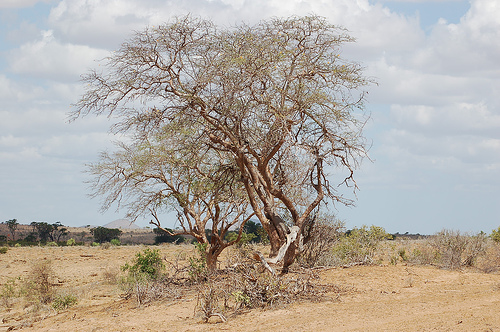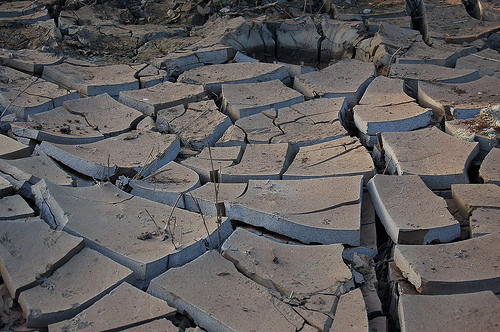The United States Agency for International Development (USAID) referred to the drought as “the most severe food security emergency in the world today.” Beyond the devastating impacts locally, this humanitarian crisis is ultimately threatening the stability of the entire region. It poses an immense challenge for East African governments, international agencies, and humanitarian organizations which must address both the short-term practical needs of the people, and consider the long-term well-being of the Horn of Africa.
Droughts and dry seasons are normal, cyclical and annual occurrences in East Africa, but the scale of the recent drought has by far exceeded any other drought in the last half-decade. Rajiv Shah of USAID stated that “eleven and a half million people are at real risk of malnutrition and famine.” This drought is the fifth in the region in the last seven years. The severe dry spells, continually increasing in intensity and frequency, have rendered farmland useless, stunted crops, and devastated livestock; leading to a dramatic inflation of food prices. In northern parts of Kenya, the price of maize has increased by 57% over the past year.
This has created a troubling situation since millions of people have become completely reliant on the extensive aid pouring in from international aid organizations. Furthermore, the actual drought is not predicted to end until October. Food security, access to potable water, and shelter are the most immediate concerns. Until such needs are attended to, millions of people will continue to be forced off their arid lands and move towards places and regions that have been less affected by the drought. Oxfam has reported a 23% rate of “severe malnutrition;” humanitarian emergencies in the past have usually only reported 4%.

Many experts are viewing this crisis as the climax reached due to many different factors, the primary of which is the failure of the government to provide adequate social infrastructure. Poor accessibility of basic transport, resource infrastructure, and health infrastructure worsens the food and water security in the region. Resultantly, the effects of the reduced rainfall are intensified. These aspects have greatly increased the severity of this dry season relative to any other, as “high food prices, fluctuating rainfall, a rising population, and ever dwindling natural resources have created the perfect storm,” says Leigh Daynes, the Director of Communications, of Plan UK.
Humanitarian organizations such as Oxfam are scrambling to mobilize resources to support the millions of thirsty and starving victims of the crisis. This response unfortunately comes in midst of declining aid, due to something Manoj Juneja of the Food and Agriculture Organization calls “donor fatigue.” This phenomenon has most recently manifested with the drought crisis. Of the $US 500 million requested in aid during the beginning of sparse rainfall for countries such as Djibouti and Kenya, only 30% was actually offered by donor countries. These governments have tightened their aid contributions after giving substantial aid to other crises in recent years, such as Pakistan, Japan, and Haiti.
Funding for projects dedicated to providing sanitary water for the developing world have experienced shortfalls long before these recent disasters. Using data collected by the Organization of Economic Cooperation & Development (OECD), WaterAid published reports stating that over the last decade aid allocated to the accessibility of potable water shrank from 8% to 5%. “It shows how far water and sanitation have slipped down the list of donor priorities,” observed John Garrett, the senior policy analyst at WaterAid. While a 3% decrease does not seem significant, the impact of investing in clean water and sanitation projects is immense when you consider the developmental byproducts of this investment. The World Bank estimates that a lack of sanitation reduces the GDP of developing countries by 6%. Sanitation issues are also linked to negative social impacts, such as lowered school attendance for young girls.
With global contribution to water sanitation projects shrinking, the lack of infrastructure to provide this basic necessity has intensified the catastrophe. The World Bank’s water chief, Julia Bucknall has estimated about 2.6 billion people “die of diarrhea caused by dirty water or inadequate sewage systems,” and that figure will only increase in such dire situations as that in East Africa. The reality remains that more investment is needed into preventative projects and programmes. As Camilla Knox-Peebles, a food security specialist with Oxfam, says:“It is hard to get funding to tackle deeper-seated problems until there is an emergency.” Global organizations and donor countries need to recognize the importance of investing in projects that help to ensure proper access to clean water. To safeguard against dry seasons or droughts transforming into full-blown humanitarian emergencies, a preventative approach, rather than a latent reactive one, is needed.
What will make the effort to formulate long-term strategic solutions difficult are some of the unique challenges facing the countries affected. In Kenya, for example, 3.5 million people are in need of assistance. Kenya’s population is experiencing a serious land-grabbing problem at the hand of the government—the appropriation of land is driving Kenyans from their homes and further worsening food security. Water-rich areas such as the Tana Delta have been parceled off by the Kenyan government to western multinational corporations, such as Bedford Biofuels (CAN) and G4 Industries Ltd (UK), to grow water-intense crops and biofuels, including sugarcane and jatropha. These plots of land, rather than being used to aid the millions of malnourished citizens, are being used to fuel western needs. These acts of government negligence and greed play a significant role in the food and water crisis.
The severe drought in East Africa is ravaging lives in the region. International response is slowly mounting the gravity of the situation. However, the severity of this crisis is a function of more deeply rooted factors, such as lack of aid towards infrastructure, which have built up and placed the region in a state of emergency. Jeffrey Sachs, a leading development expert, calls for a sustained investment in the dry lands to help eradicate the poverty that has caused the catastrophe that is unfolding before the world’s eyes - one that will affect and dictate the trajectory of the region, and more importantly, the affected lives that hang in the balance. It will not be enough to just respond accordingly to this humanitarian crisis by feeding the millions suffering from the famine. Rather, it is of paramount importance to address the many determinants of the drought to prevent the region from being victimized by unavoidable natural circumstances, and dependent on foreign emergency aid.
Photo: Matt and Kim Rudge (flickr)
 Log in
Log in









